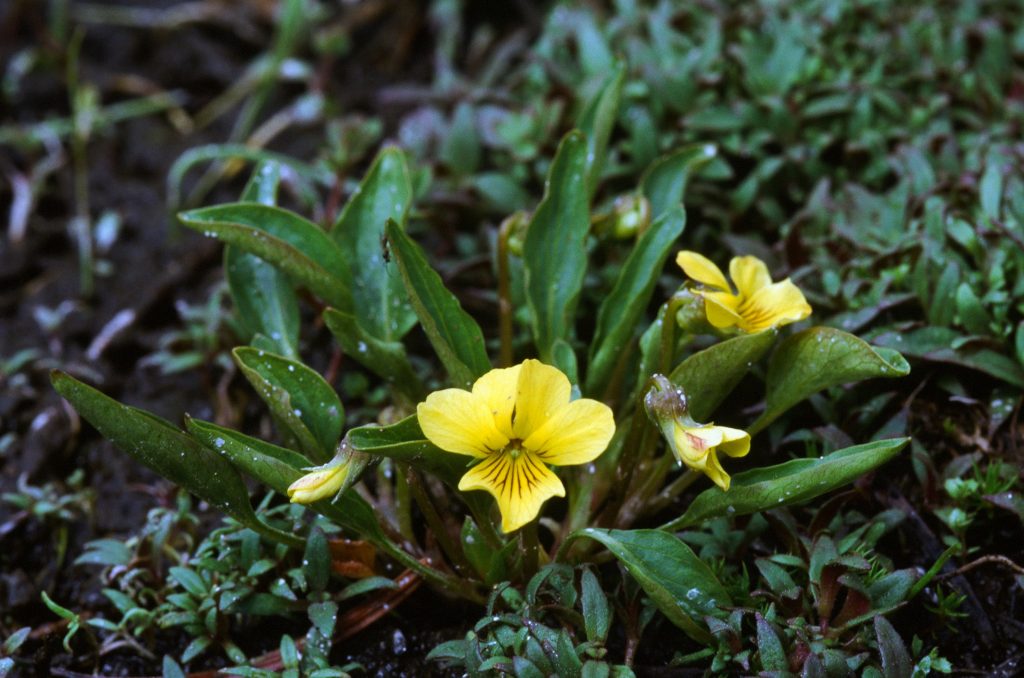Viola bakeri
Description. Illustrations: 1 photograph of Viola bakeri and 1 drawing.
Viola bakeri (near Lake Tahoe, CA. June 1998).
A dwarf, tap-rooted species with pale yellow flowers occurring from the upper altitudes of the Sierra Nevada mountains of mid-California, Oregon and southern Washington state. The green plants are more or less summer-dormant, growing as tufts of entire, lanceolate, glabrous leaves in open ground. It blooms at 6-7cm high, soon after the snow melts.
The rootstock branches at the top into persistent woody divisions. Densely-packed short, fat stems arise a few centimetres underground from the top of the vertical rhizome.
Basal and cauline leaves are oblong-lanceolate, basal 2.5-3.5 cm long. Leaf blade not cut or lobed; petiole 1–8 cm, lightly puberulent; cauline blades approximately 55 mm, lanceolate, either glabrous or with narrow hairs on margins, veins, or throughout, base tapered, tip obtuse or acute, leaves regularly much longer than broad.
The flowers, are pale yellow on both sides, not having the rust on the back as in V. nuttallii, 1.5-1.6 cm. The front of the lowest 3 petals, including spur, veined brownish, lateral 2 petals glabrous near base, ovary glabrous. Flowering May-July, depending on altitude and the season. Triangular bracteoles, 0.25 cm long with a few glandular-tipped fimbriae at base, wrap around the peduncles just below the middle. Peduncles 15–75 mm; green plus red, glabrous. Sepals and auricles 0.75 cm long.

Seed pods glabrous to puberulent, sub-globose, 5–9 mm long. Seeds pale to mid-brown, 2.5 x 1.4 mm.
Viola bakeri occurs in dry clearings, between 1100-2700 m, in mixed coniferous forests: White Fir (Abies concolor), Red Fir (Abies magnifica), Incense Cedar (Libocedrus decurrens), Lodgepole Pine (Pinus contorta), Jeffrey Pine (Pinus jefferyi), Sugar Pine (Pinus lambertiana), Ponderosa pines (Pinus ponderosa) and Douglas Fir (Pseudotsuga menziesii) and Redwood (Sequoia sempervirens). Growing in sloping sandy soil and sometimes in a drainage basin that is damper than where V. tomentosa or lobata grow nearby. Also with Viola adunca. The bedrock granite is part of the great Sierra Nevada batholith.
Ranging from central and northern California to southernmost Washington state. CA: El Dorado County, Nevada County, Placer County, Plumas Co. Shasta County, Trinity Co., Tehama Co. [spelling: Eldorado Nat. Forest, but El Dorado Co.] Cascade and Siskiyou Mountains. High Sierra Nevada. OR: Jackson Co., V. bakeri recorded from area of Crater Lake.
Nomenclature & Taxonomy
Section Chamaemelanium Ging., subsection Nuttallianae (Marcussen, 2011).
V. bakeri Greene.
(syn. Viola bakeri subsp. shastensis Baker, M.S., Madrono 15:203. 1960.
V. bakeri subsp. shastensis M.S. Baker, subsp. grandis M.S. Baker & J.C. Clausen illegitimate.
Collected by M.S. Baker, 1 July 1955.
2N=8x=48 (polyploid) where x=6, the base chromosome number for section Chamaemelanium.
Chromosome analyses (TM, 2011) show that V. bakeri originated by inter-subsectional hybridization followed by allopolyploidy about 4.3 million years ago. The unidentified parents of the hybrid cross that formed V. bakeri before the alloploidy event were: a member of subsection Canadenses, one from subsection Chrysanthae, one member of the Nuttallii subsection and one maternal parent from Series Nudicaules. In addition to these each hybrid contained at least one homoeolog corresponding with the subsection to which it had previously been assigned based on ecology and morphology. This phenomenon of hybridization followed by alloploidy seems common within section Chamaemelanium and has occurred repeatedly in the last 9 million years for at least four other taxa (V. guadalupensis, V. douglasii, V. glabella, and V. sempervirens).
Each of the polyploids possessed at least one homoeolog derived from these groups and at least one corresponding to the subsection to which it had been assigned based on morphology and ecology.
